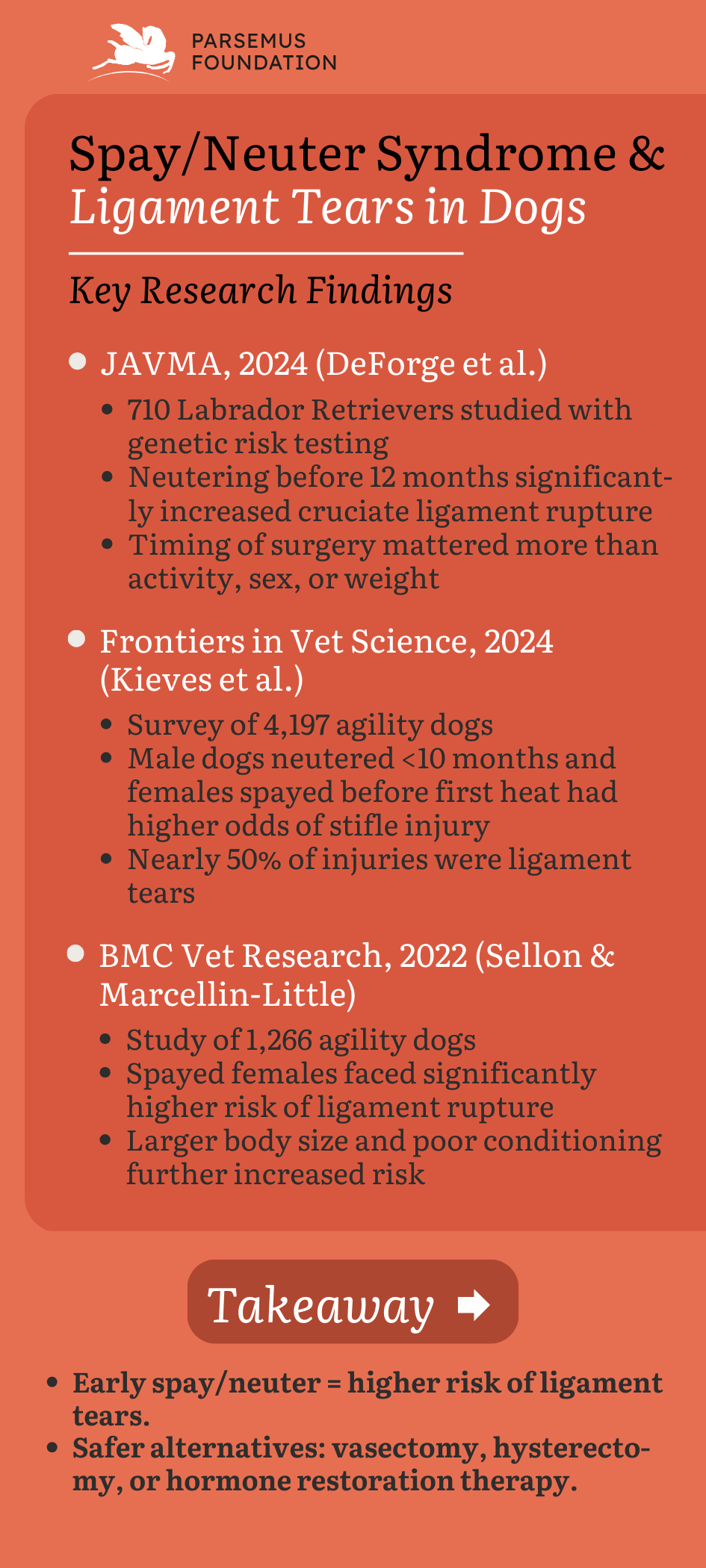Gonadectomy, especially done early, raises the odds of injury
The Parsemus Foundation is committed to sharing science about spay/neuter syndrome — the health problems that can follow removal of a dog’s gonads (or gonadectomy). One area of concern is the risk of ligament tears, especially cranial cruciate ligament rupture (CR or CCLR). This painful injury is one of the leading causes of lameness in dogs and often requires expensive surgery. Recent research shows that early spaying or neutering can raise the odds of these injuries.
See our web page on How Spaying and Neutering Affect Health.
Key research findings
A study led by Susannah Sample, DVM, Ph.D. of the University of Wisconsin-Madison, was published in the Journal of the American Veterinary Medical Association in October 2024. It examined Labrador Retrievers, a breed prone to cruciate ligament rupture. The researchers used genetic testing to separate dogs with high and low inherited risk. They found that neutering before 12 months of age was a significant environmental factor that increased the risk of ligament rupture, even in dogs without strong genetic predisposition.
Another study, led by Nina R. Kieves, DVM, of the Ohio State University, appeared in Frontiers in Veterinary Science in February 2024. This large survey of more than 4,000 agility dogs found that early gonad removal strongly increased the risk of stifle injuries (the stifle joint is the canine equivalent of a knee). Male dogs neutered before 10 months of age and female dogs spayed before their first heat cycle faced higher odds of injury. Nearly half of these injuries were cruciate ligament tears. The researchers also confirmed that heavier dogs and certain breeds, like Border Collies, faced higher risks.
Earlier evidence points in the same direction. In 2022, Debra C. Sellon, DVM, Ph.D., of Washington State University and Denis J. Marcellin-Little, DEDV, of UC Davis, published a study in BMC Veterinary Research. They found that spayed female dogs had a significantly higher risk of cranial cruciate ligament rupture compared to intact females. This work also showed that larger body size and reduced core conditioning further increased injury risk.

Growing evidence that hormone-sparing sterilization may be a better option
These studies, published in peer-reviewed journals, strengthen the case that early spay and neuter raises the risk of ligament tears across breeds and activities. For many dogs, the timing of surgery can make the difference between years of sound movement and a painful orthopedic problem.
The studies add to growing evidence that conventional spay and neuter surgeries, which result in a lack of hormones due to the loss of the sex organs that produce them, sometimes result in serious health complications.
This news gives dog owners another reason to consider hormone-sparing sterilization methods. Hysterectomy for females and vasectomy for males prevent unwanted litters while keeping natural hormones intact.
Hormone restoration therapy may help
If your dog has already been spayed or neutered, and shows signs of problems commonly associated with “spay/neuter syndrome,” you can consult a veterinarian about whether hormone restoration therapy may help. The therapy aims to rebalance hormones lost through spay or neuter surgery. Little research has been done on this new treatment area, but a recent study of testosterone therapy for castrated male dogs was promising.
See our web page on Hormone Restoration in Dogs.
The Parsemus Foundation maintains a directory of veterinarians who offer hormone restoration therapy. Find it here: parsemus.org/vet-directory
See our other news articles on hormone-sparing sterilization in pets and pet hormone replacement.


